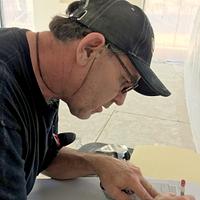Share your craft projects
Make new craft buddies
Ask craft questions
Blog your craft journey

shipwright
2135 posts
and
113 followers
in over 11 years
in over 11 years
Shipyard Memories #6: The Big Day: Launching
This is
part 6
in a
22 part
series:
Shipyard Memories
Now we are nearing the big day, launching. The hull has been faired and sanded and is ready for it's finish. The chosen product was Deks Olje, a two stage system where you first apply several coats of an oil (Deks Olje #1) followed by a couple of gloss coats (Deks Olje #2). Very much the way I use Cetol Marine / Cetol Marine Gloss now. The seams above the waterline are filled with a thiokol product and below the waterline with cement.

The finish is on, the bottom is painted with anti fouling and the bowsprit is in place, Just about ready to go.

Smaug sees the sun for the first time. My shop was in an old second world war era hanger that once housed the Stranraers, PBY's and Cansos that patrolled the west coast looking for Japanese submarines.

Launching day at my shop was always a big party. We supplied food and usually had a dinghy full of ice and beer and the whole town came out to watch. Fortunately Coal Harbour was a very small town. This shot is my choice for "best launching photo ever". What's so cool about it is that up in the air, about 20' above the owner's head (right where he's looking) the original photo shows a tiny spec. That spec is the cork that he just popped off the champagne bottle in his hands as the keel hit salt water. Sadly the scanner, try as it would, was unable to pick it up.

The launching ramp here was originally built for large seaplanes, not boats. It isn't quite steep enough for boats. In this photo the truck can't go any further and the boat is not quite afloat. We got her off by the boat mover lifting on the front of the trailer while I did tugboat duty with my 19' catboat.

She nestled into the water just like a duck and seemed very happy to be there. In this shot you get the best look I have of the forward cabin skylight. It is a tricky little construction. It has more than one challenge but the most interesting is that to be right a hatch or skylight like this should have plumb ends, not square to the deck which is rising forward… and it has dovetailed corners. Not that hard, but it gets you thinking. Another feature in this shot is the "catheads", the 4×4 gumwood spars angling out from the sampson posts to act as bowsprit shroud spreaders. Traditionally these were used to "cat up the anchor" keeping it away from the hull. They frequently had cast bronze cat faces on the ends.

And here's that stern view that I like so much again. You get a good look here at the rudder head coming up through the pinky stern and the little sternpost at the end of the bulwarks.

This last photo I included because I love the little jewel of sunlight sitting on the rail cap. It was a perfect day and that just seems to have been a blessing bestowed upon her on her big day. The other interesting feature in this angle is that you can see the yellow cedar inlays in the mahogany hatch covers.

Thanks for checking in again . Please feel free to ask questions. I'm having a great time with this.
Next time I'll show some interior details and then we'll finish up with some sailing photos.
Thanks again
Paul
The early bird gets the worm but its the second mouse that gets the cheese.
3 Comments
Sweet lines on her. That is the way a sailing craft should look. Great photos.
Main Street to the Mountains
That's a beauty. She sure looks good on the water. Must have been fun getting her in.
So you basically spread cement, like thin set with a bondo spreader on the bottom seams? Caulking gun?
What is anti fouling?
So you basically spread cement, like thin set with a bondo spreader on the bottom seams? Caulking gun?
What is anti fouling?
Figuring out how to do something you have never done is what makes a good challenge.
Thanks Bently.
We used a mix of cement powder and baking soda and applied it with a putty knife. It’s only about a quarter inch deep.
Anti fouling is the paint applied below the waterline AKA bottom paint to inhibit the growth of barnacles, mussels, etc.
We used a mix of cement powder and baking soda and applied it with a putty knife. It’s only about a quarter inch deep.
Anti fouling is the paint applied below the waterline AKA bottom paint to inhibit the growth of barnacles, mussels, etc.
The early bird gets the worm but its the second mouse that gets the cheese.










